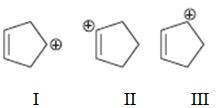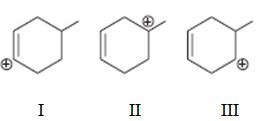
Concept explainers
a)

Interpretation:
The order of increasing stability among the carbocations shown is to be stated.
Concept introduction:
Carbocations are stabilized either by resonance or by hyperconjugation or by the inductive effect of the substituents. Among these resonance plays an important role. The order of stability of carbocations is allylic>tertiary>secondary>primary>methyl>vinylic.
To state:
The order of increasing stability among the carbocations shown.
b)

Interpretation:
The order of increasing stability among the carbocations shown is to be stated.
Concept introduction:
Carbocations are stabilized either by resonance or by hyperconjugation or by the inductive effect of the substituents. Among these resonance plays an important role. The order of stability of carbocations is allylic>tertiary>secondary>primary>methyl>vinylic.
To state:
The order of increasing stability among the carbocations shown.
c)

Interpretation:
The order of increasing stability among the carbocations shown is to be stated.
Concept introduction:
The stability of carbocations is in the order tertiary>secondary>primary. The carbocations can be stabilized either by resonance or by hyperconjugation or by the inductive effect of the substituents. Among these resonance plays an important role. The order of stability of carbocations is allylic>tertiary>secondary>primary>methyl>vinylic.
To state:
The order of increasing stability among the carbocations shown.
Trending nowThis is a popular solution!

Chapter 9 Solutions
Study Guide with Student Solutions Manual for McMurry's Organic Chemistry, 9th
- ASP please....arrow_forwardNonearrow_forwardConsider the structure of 1-bromo-2-fluoroethane. Part 1 of 2 Draw the Newman projection for the anti conformation of 1-bromo-2-fluoroethane, viewed down the C1-C2 bond. ✡ ぬ Part 2 of 2 H H F Br H H ☑ Draw the Newman projection for the gauche conformation of 1-bromo-2-fluoroethane, viewed down the C1-C2 bond. H F Br H Harrow_forward
- Please help me answer this question. I don't understand how or where the different reagents will attach and it's mostly due to the wedge bond because I haven't seen a problem like this before. Please provide a detailed explanation and a drawing showing how it can happen and what the final product will look like.arrow_forwardWhich of the following compounds is the most acidic in the gas phase? Group of answer choices H2O SiH4 HBr H2Sarrow_forwardWhich of the following is the most acidic transition metal cation? Group of answer choices Fe3+ Sc3+ Mn4+ Zn2+arrow_forward
- Based on the thermodynamics of acetic acid dissociation discussed in Lecture 2-5, what can you conclude about the standard enthalpy change (ΔHo) of acid dissociation for HCl? Group of answer choices You cannot arrive at any of the other three conclusions It is a positive value It is more negative than −0.4 kJ/mol It equals −0.4 kJ/molarrow_forwardPLEASE HELP URGENT!arrow_forwardDraw the skeletal structure corresponding to the following IUPAC name: 7-isopropyl-3-methyldecanearrow_forward
 Organic Chemistry: A Guided InquiryChemistryISBN:9780618974122Author:Andrei StraumanisPublisher:Cengage Learning
Organic Chemistry: A Guided InquiryChemistryISBN:9780618974122Author:Andrei StraumanisPublisher:Cengage Learning
